Click on images to enlarge
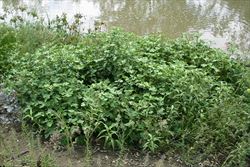
infestation (Photo: Sheldon Navie)
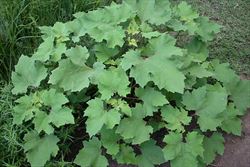
habit (Photo: Sheldon Navie)
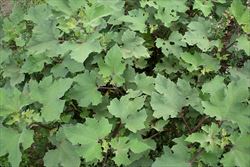
habit (Photo: Sheldon Navie)
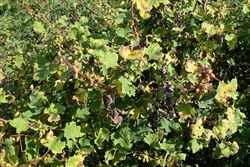
habit of old plant in fruit (Photo: Sheldon Navie)
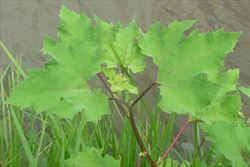
leaves with noticeably lobed margins (Photo: Sheldon Navie)

leaf (Photo: Sheldon Navie)
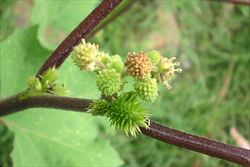
stems with male and female flower-heads (Photo: Sheldon Navie)
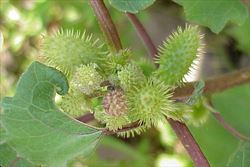
close-up of rounded male flower-heads and larger immature fruit (Photo: Sheldon Navie)
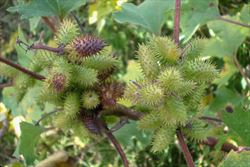
clusters of immature fruit (Photo: Sheldon Navie)
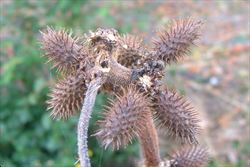
mature fruit (Photo: Sheldon Navie)
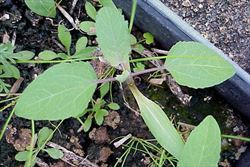
seedling (Photo: Sheldon Navie)
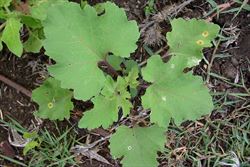
young plant (Photo: Sheldon Navie)

the very similar Californian burr (Xanthium orientale), with larger fruit and less-lobed leaves (Photo: Forest and Kim Starr, USGS)
Scientific Name
Xanthium strumarium L.
Synonyms
Xanthium strumarium Bertol.
Xanthium chinense Mill.
Xanthium pungens Wallr.
Xanthium strumarium L.
Xanthium strumarium L. var. glabratum (DC.) Cronq.
Family
Asteraceae (Queensland, New South Wales, the ACT, Victoria, Tasmania, Western Australia and the Northern Territory)Compositae (South Australia)
Common Names
beach cocklebur, common cocklebur, European cockle bur, European cockle burr, European cocklebur, European cockleburr, large cockle bur, large cocklebur, large cockleburr, Noogoora burr, rough cocklebur, rough cockleburr
Origin
Probably originated in the Americas, but now widespread throughout the world (i.e. cosmopolitan).
Naturalised Distribution
Noogoora burr (Xanthium strumarium) is very widespread, particularly in the eastern half of the country. It is common throughout most of Queensland and New South Wales and is relatively common in some parts of the Northern Territory, northern Victoria and south-eastern South Australia. Scattered populations also occur in the northern and south-western parts of Western Australia.
Habitat
A widespread weed of crops, cultivation, pastures, waterways (i.e. riparian areas), floodplains, roadsides, disturbed sites and waste areas in temperate, semi-arid, sub-tropical and tropical environments.
Habit
This upright (i.e. erect) or spreading short-lived (i.e. annual) herbaceous plant usually grows to about 1 m tall, but occasionally reaches up to 2.5 m in height.
Distinguishing Features
- an upright or spreading short-lived herbaceous plant usually growing to about 1 m in height.
- its much-branched stems are covered in short, stiff, hairs that give them a rough texture.
- its large, broad, irregularly toothed leaves are also rough to the touch and commonly have three or five broad lobes.
- separate male and female flower-heads are produced on different regions of the branches.
- its fruit is a shortly-stalked and oval-shaped 'burr' (7-20 mm long) containing two seeds.
- this fruit is covered in numerous hooked spines (about 2 mm long) and has two larger spines (about 4 mm long) at its tip.
Stems and Leaves
The thick upright (i.e. erect) stems are usually much-branched, giving the plant a spreading habit. These greenish stems often have purplish blotches or streaks and are covered in short, stiff, hairs that give them a rough (i.e. scabrous) texture.
The lower leaves are oppositely arranged, while the upper leaves are alternately arranged. These large and broad leaves (4-20 cm long and 3-18 cm wide) are roughly egg-shaped in outline (i.e. ovate) or somewhat triangular in shape and are borne on stalks (i.e. petioles) 2-12 cm long. They are coarsely toothed (i.e. serrate) and are usually divided into three or five indistinct lobes. The leaves are borne on long, grooved stalks (i.e. petioles) 10-20 cm long and are covered in small hairs or tiny bristles that give them a very rough texture (i.e. they are also scabrous).
Flowers and Fruit
Separate male and female (i.e. unisexual) flower-heads (i.e. capitula) are produced on different parts of the same plant (i.e. plants are monoecious). The male flower-heads (5-8 mm across) are produced in clusters at the tips of the branches, along with a few female flower-heads at the bottom of these clusters. The female flower-heads are also borne in small clusters at the base of the upper leaf forks (i.e. in the upper leaf axils). These greenish or yellowish coloured flower-heads are relatively inconspicuous until the fruit begin to mature. Flowering occurs from summer through to early autumn (sometimes into winter in warmer areas).
The fruit are greenish when young, turning yellowish and then finally brown in colour as they mature. They are oval-shaped (i.e. ellipsoid) 'burrs' containing two seeds. These 'burrs' (7-20 mm long) are shortly-stalked (i.e. sub-sessile) and are borne in groups of 2-13 along the branches. They are somewhat hairy (i.e. pubescent) when young, covered in numerous hooked spines (about 2 mm long), and have two terminal spines or 'beaks' (about 4 mm long). These fruit become quite woody and are usually produced during late summer and autumn. The seeds (4-15 mm long and 5-7 mm wide) are brown or black in colour, flattened on one side, and one seed in each pair is usually slightly larger than the other.
Reproduction and Dispersal
This species reproduces entirely by seed.
The 'burrs' are well adapted for dispersal, due to their hooked spines, and readily become attached to animals, clothing and vehicles. They may also be spread by water, during road maintenance activities, and in contaminated agricultural produce (e.g. particularly in wool).
Environmental Impact
Noogoora burr (Xanthium occidentale) is regarded as an environmental weed in Queensland, the Northern Territory, Western Australia and New South Wales. It was recently listed as a priority environmental weed in seven Natural Resource Management regions.
Legislation
This species is declared under legislation in the following states and territories:
- ACT: C2 - a pest plant that must be suppressed.
- New South Wales: Class 4 - a locally controlled weed. The growth and spread of this species must be controlled according to the measures specified in a management plan published by the local control authority and the plant may not be sold, propagated or knowingly distributed (in a large number of local authority areas). See the New South Wales Department of Primary Industries Noxious Weeds List at http://www.dpi.nsw.gov.au for more detailed information on which local areas are covered in these declarations.
- Northern Territory: B - spread to be controlled (throughout all of the Territory), and C - not to be introduced into the Territory.
- South Australia: N* - this species is listed as a Class 2b weed, a classification for dangerous agricultural weeds. Control is required in part of the state only, but trade and movement is usually restricted throughout the entire state.
- Tasmania: D - the importation or sale of this species is prohibited and measures to reduce its population in an area, eradicate it from an area, or restrict it to a particular area may be required. This declaration applies to all burr species (Xanthium spp.).
- Victoria: P2 - prohibited and must be eradicated or controlled (in the Wimmera and Glenelg regions), and C4 - all reasonable steps must be taken to control the weed and prevent its spread (in the Mallee, North Central, Corangamite, Goulburn and North East regions).
- Western Australia: P1 - trade, sale or movement of this species or its seeds is prohibited (throughout the entire state), P2 - to be eradicated (throughout the whole of the state, except for the Broome, Derby-West Kimberley, Halls Creek and Wyndham-East Kimberley local authority areas), and P4 - this species cannot be eradicated in the short term, but must be 'contained' (in the Broome, Derby-West Kimberley, Halls Creek and Wyndham-East Kimberley local authority areas).
Management
For information on the management of this species see the following resources:
- the Biosecurity Queensland Fact Sheet on this species, which is available online at http://www.dpi.qld.gov.au.
- the New South Wales Department of Primary Industries Agfact on this species, which is available online at http://www.dpi.nsw.gov.au.
- the Northern Territory Department of Natural Resources, Environment and The Arts Agnote on this species, which is available online at http://www.nt.gov.au/weeds.
- the Western Australian Department of Agriculture and Food Farmnote on this species, which is available online at http://www.agric.wa.gov.au.
Similar Species
Noogoora burr (Xanthium strumarium) is one of the closely related species that make up the Noogoora burr complex (Xanthium strumarium sp. agg.). The species in this complex can be distinguished by the following differences:
- Noogoora burr (Xanthium strumarium) has leaves that are quite deeply three or five lobed and its stems are usually covered with purplish streaks or blotches. Its relatively small fruit (7-20 mm long) are topped with two relatively small (about 4 mm long) straight 'beaks' that are parallel or slightly divergent.
- South American burr (Xanthium cavanillesii) has leaves that are not distinctly lobed or shallowly lobed, and the base of the leaf blade is somewhat heart-shaped (i.e. cordate). Its relatively large fruit (15-30 mm long) are topped with two relatively large (6-8 mm long) straight 'beaks' that are usually divergent.
- Hunter burr (Xanthium italicum) has leaves that are usually distinctly, but not deeply, three lobed. Its relatively large fruit (20-30 mm long) are topped with two relatively large (about 7 mm long) divergent 'beaks' that are incurved at their tips.
- Californian burr (Xanthium strumarium) has leaves that are distinctly three lobed and its stems are green or reddish brown in colour. Its relatively small fruit (15-20 mm long) are topped with two relatively small (4-6 mm long) divergent 'beaks' that are incurved and hooked at their tips.
Noogoora burr (Xanthium strumarium) may occasionally also be confused with Bathurst burr (Xanthium spinosum). These species can be distinguished by the following differences:
- Noogoora burr (Xanthium strumarium) has relatively large leaves (up to 20 cm long) that are very broad (up to 18 cm across) and often have three or five lobes with irregularly toothed margins. Both leaf surfaces are green in colour and rough to the touch (i.e. scabrous). Its stems do not bear any spines and its relatively large fruit (7-20 mm long) are topped with two distinct 'beaks' (about 4 mm long).
- Bathurst burr (Xanthium spinosum) has small to moderately sized leaves (2-10 cm long) that are relatively narrow (6-30 mm wide) and usually have three irregular lobes. These leaves have dark green upper surfaces and whitish coloured undersides. Its stems bear three-pronged spines near the leaf bases and its moderately-sized fruit (8-15 mm long) are sometimes topped with two small 'beaks' (1-2 mm long).

